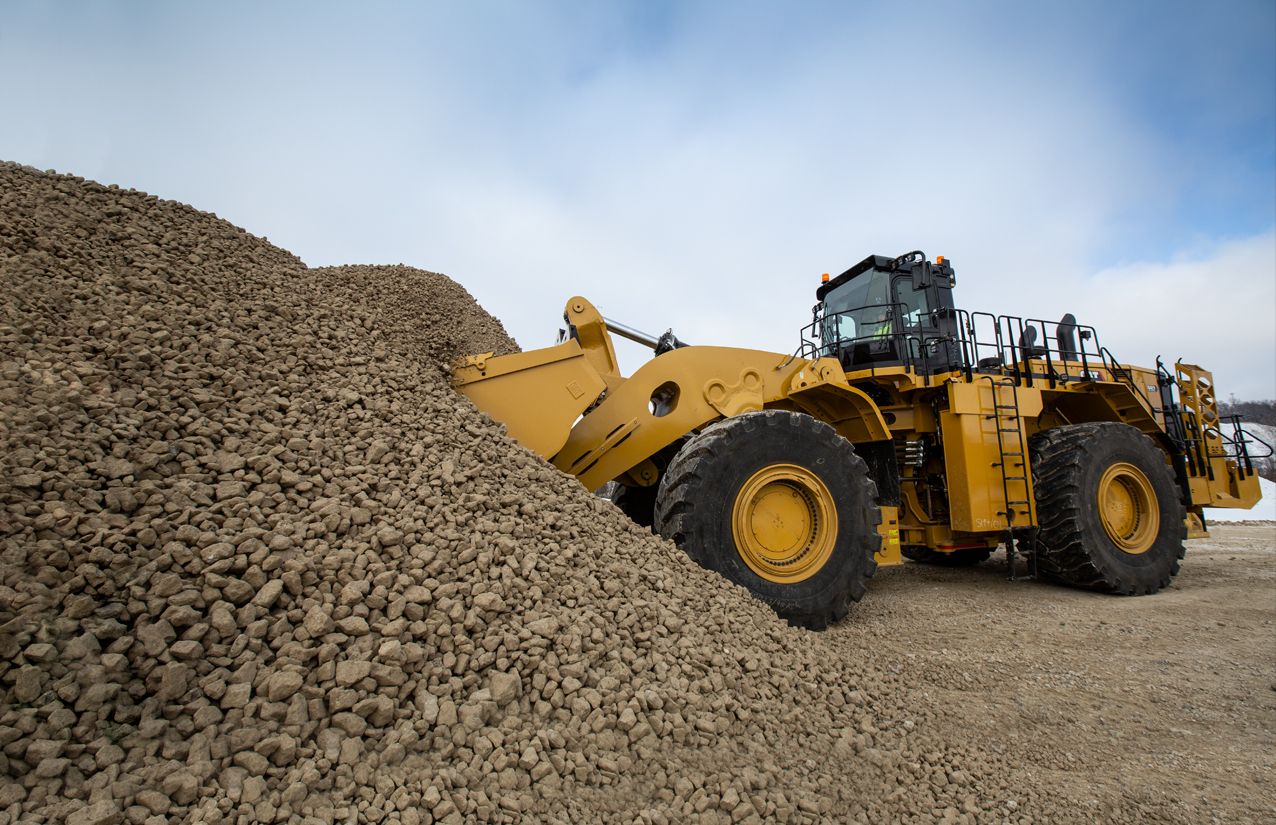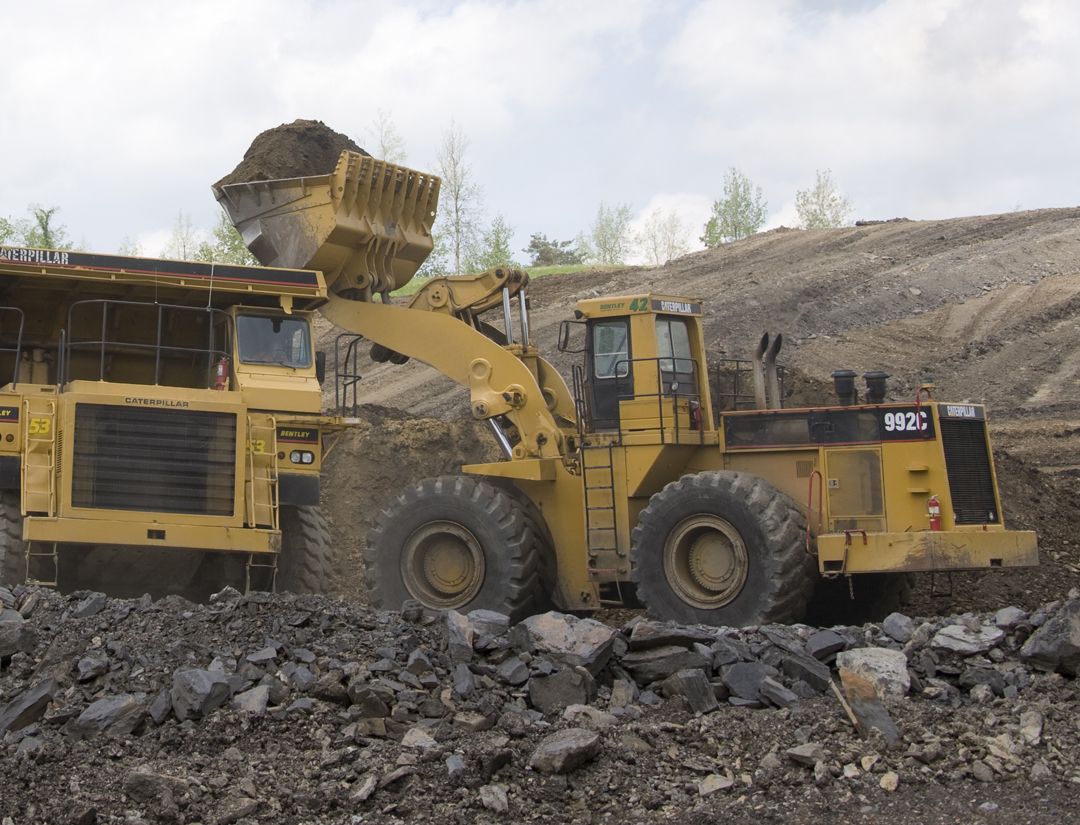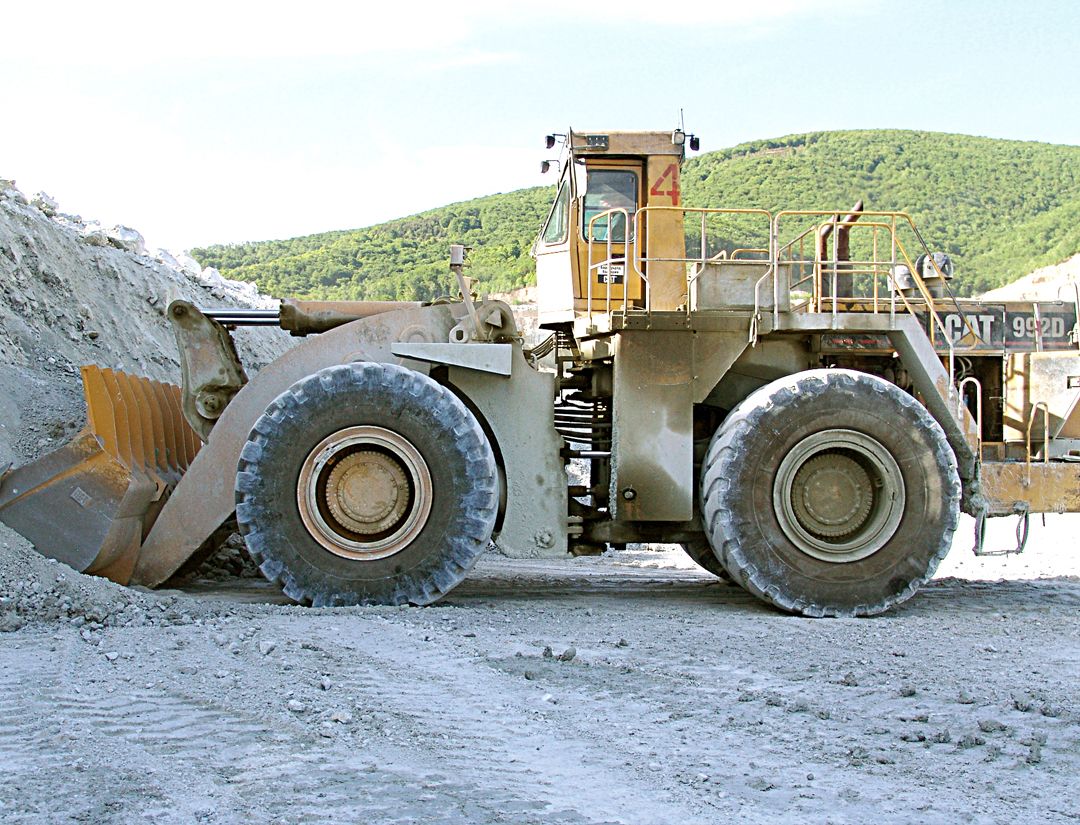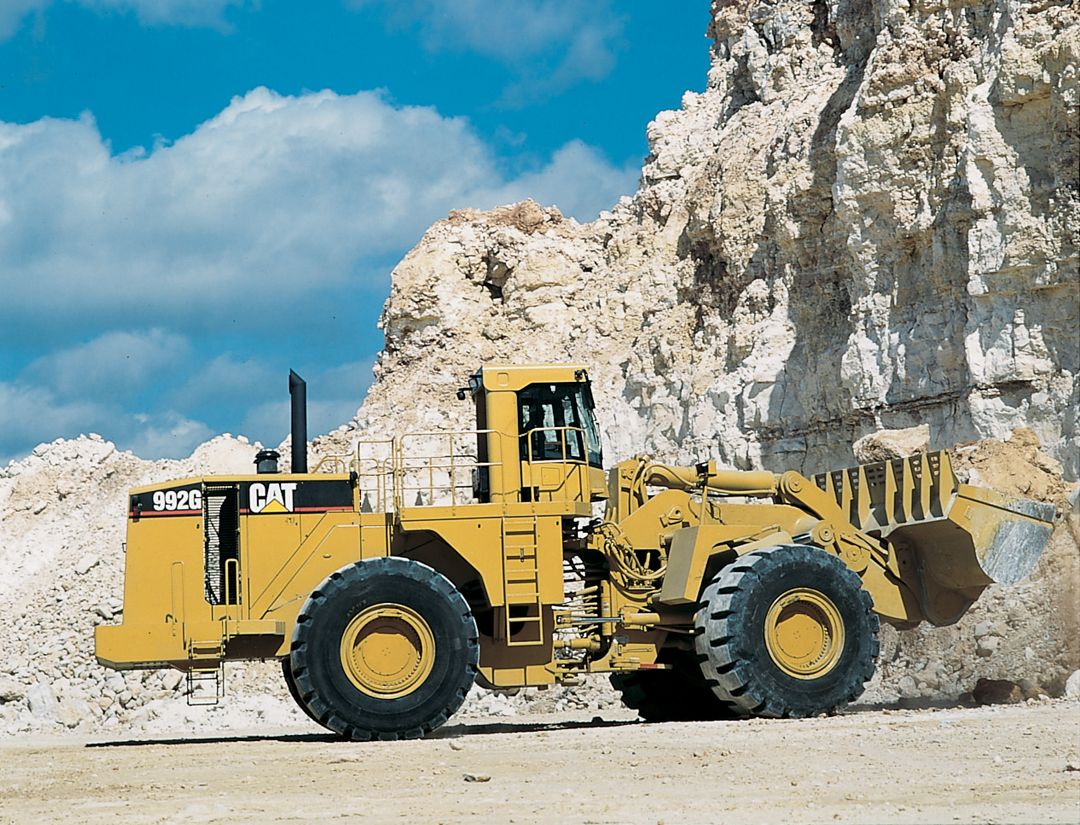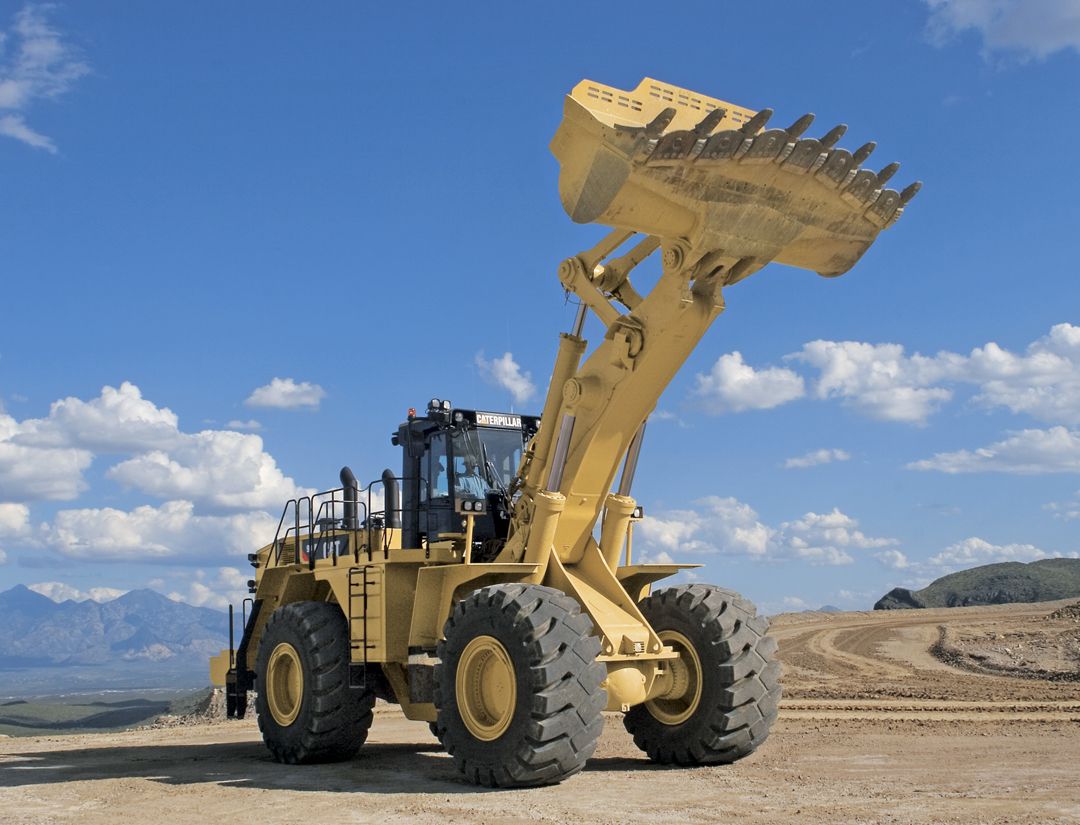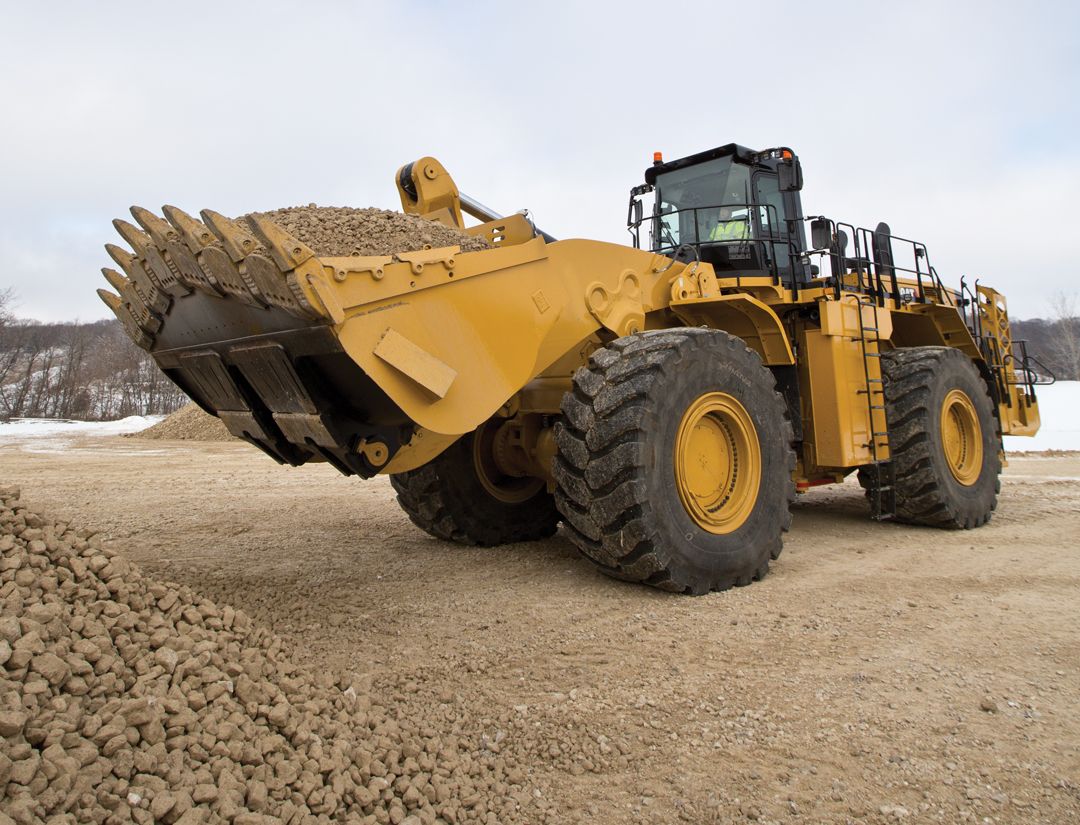

Sign In
Welcome! Sign In to personalize your Cat.com experience
If you already have an existing account with another Cat App, you can use the same account to sign in here
Register Now
One Account. All of Cat.
Your Caterpillar account is the single account you use to log in to select services and applications we offer. Shop for parts and machines online, manage your fleet, go mobile, and more.
Account Information
Site Settings
Security
Setting the Standard: The History of the Iconic Cat® 992
Since 1968, the 992 has been setting the bar for large wheel loader performance. Learn more about this machine's history — and what comes next.
By Caterpillar | Posted January 16, 2023
Caterpillar recently released its latest model of the Cat® 992 Large Wheel Loader, using the theme of “Setting the standard, then raising the bar” to promote the new machine. It’s an appropriate message for the newest version of one of the most successful mining class wheel loaders every produced.
From high productivity to unmatched reliability and long life, the 992 has been leading the way in wheel loaders since its introduction in 1968.
Joel Busker, a senior engineering specialist at Caterpillar, has worked on the design of the linkage and structures of multiple generations of the 992 over the past 25 years and agrees that the newest model raises the bar.
“Needless to say, I was excited to have the opportunity to work on this latest version,” said Busker. It is such an iconic machine in the industry, and it was a privilege to work on the best one yet.”
Every iteration of this popular machine has incorporated new innovations and improvements intended to keep raising the bar, according to John Marek, a product application specialist and former design engineer for Cat Large Wheel Loaders. “Over the past five decades, we’ve increased capacity, made it faster, added new safety features, made it larger and taller ― all to meet the demands of our customers,” he said.
The newest version of the 992 builds on more than 50 years of continuous improvement to deliver a significant increase in productivity without increasing fuel usage. And it incorporates features that make it even more comfortable and productive for the operator.
“We’re really proud of this new machine,” said Marek. “It’s a game-changer in so many ways.
BUILDING THE INDUSTRY STANDARD
Like all new Cat machines, development of the 992 Wheel Loader started with a customer need ― in this case the mining industry’s demand for larger, more productive equipment.
Development began in the early to mid-1960s, resulting in a prototype machine with an 8-cylinder Cat D345 engine with 500 flywheel horsepower. By the time field trials began in 1966, the 992 had been equipped with a more powerful engine ― the 550-horsepower V-12 D348 Diesel Twin Turbo.
The 992 was officially launched in 1968, with the first machine going to one of its field trial sites, the Duval mine located in Twin Buttes, Arizona.
With a 10-cubic-yard bucket and capacity of 15 tons, the first 992 nearly doubled the capacity of Caterpillar’s largest wheel loader at the time ― the 988. It was also almost twice the weight of the 988, with an operating weight of 60.25 tons.
FINDING ROOM FOR IMPROVEMENT: THE 992B
Five years after the 992 made its debut, the first round of improvements was released on the new Cat 992B.
The 992B was capable of top forward speeds of 25 mph and up to 27.1 mph in reverse for quicker cycle times. The 992B had the same payload capacity but had upped operating weight by nearly 15,000 pounds. A 70-degree center-point articulation ensured maneuverability while maintaining stability, delivering quicker cycle times.
Additional improvements included a standard Roll Over Protective System (ROPS) frame to protect the cab, and a redesigned main frame and loader tower that featured a box-section design to withstand bending and twisting forces while evenly distributing stress.
BUILDING AN ICON: THE 992C
The 992B continued for another few years before Caterpillar significantly raised the bar with the introduction of the iconic 992C in 1977.
The improvements made in the 992C were across the board. It was bigger and faster, with more power and breakout force, thanks in part to the new turbocharged V-12 Model 3412 diesel engine, rated at 690 flywheel horsepower.
Marek points to the redesign of the lift arms a game-changer. “The Z-bar linkage was simpler and superior at digging versus the 8-bar linkage found on the 992B.”
The 992C also introduced a high-lift loader arm that allowed it to load 120-ton trucks. The 992C featured a bucket capacity of 12.5 cubic yards ― 1.5 cubic yards more than the original. Operating weight was upped to 94 tons.
The 992C also introduced some improvements and enhancements that boosted the productivity and comfort of the operator ― like the Caterpillar Electronic Monitoring System (EMS), which allowed the operator to track critical machine systems; a sound-isolated operator’s cab; and optional climate controls.
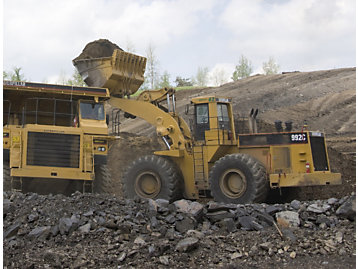
Another feature, the optional steel-shoed beadless tires, opened up new opportunities for the 992C. These tires allowed the machine to work in extreme conditions such as the sharp rock surfaces found in quarries. Today, these have been replaced with protective chain designs.
“The 992C was one of the best wheel loader designs of all time,” said Marek. “More than 2,500 were put into service worldwide, making it the best-selling large mining loader of all time. In fact, it was so well designed that it had a production run that lasted more than 20 years.”

FOCUSING ON OPERATORS: THE 992D
It wasn’t until 1992 ― 15 years later ― that Caterpillar introduced the next version of the 992 Wheel Loader. While it had a higher payload and looked very similar to the 992C on the outside, it was what was inside the new 992D that made it stand out.
For the first time in a rubber-tired loader, Caterpillar had replaced the traditional steering wheel with a new joystick STIC™ system controller. This Steering and Transmission Integrated Control System (STIC) combined directional selection, gear selection and steering into a single joystick. With a simple side-to-side motion turning the machine right or left, this system minimized operator movement and reduced fatigue.
The new cab also featured an in-cab payload management system. This was the beginning of what has now evolved into Cat Payload.
Operators also benefited from improvements outside the cab ― like access steps that were mounted over the rear tires, eliminating the need to climb a side-mounted ladder to access the cab.
Additional changes in the 992D included another boost in bucket size. Caterpillar added another 1.5 cubic yards to the bucket, bringing it to 14 cubic yards.
INTRODUCING A NEW DESIGN: THE 992G
Presented to the industry at MINExpo 1996 in Las Vegas, Nevada, the new 992G introduced a completely new design ― including another increase in payload, a significant boost in horsepower and torque, and a new front lift arm design with 3 times the torsional strength of the 992D.
The 992G was almost perfect for loading 100-ton trucks, thanks to a bucket capacity ranging from 15 to 16 cubic yards and a payload capacity of 24 tons (21.8 tonnes). Operating weight was boosted to 101 tons for the launch of the 992G, but was updated to almost 104 tons a few years later. With a greater payload, the overall machine length increased almost 8.5 feet.
The new 3508B V-12 engine boosted flywheel horsepower to 800 ― a 300-horsepower increase from the original 992. A 30% rise in torque made it possible for the 992G to operate with bigger buckets.
One of the biggest structural changes in the new 992G was the switch to a mono-boom design. This one-piece cast steel box section front lift arm design tripled the torsional loading stiffness of the 992D’s parallel lift arms

“The design of the mono-boom was intended to spread stresses over the full length and perimeter of the cast box boom,” said Marek. “This would prevent twisting and stress that can sometimes lead to cracking. And more than 90% of the 992G structure was robotically welded to provide stronger and more consistent welds.”
Additional redesigns included the full box-section rear frame, which had been strengthened internally and externally, and the front box-shaped cylinder tower, with offered improved resistance to twisting and maximum strength.

MEETING EMISSIONS REGULATIONS: THE 992K
In 2012, Caterpillar introduced its first Large Wheel Loader that met U.S. EPA Tier 4 Final exhaust emissions standards.
The new 992K was powered by a new 814-horsepower Cat C32 ACERT™ V-12 engine that was mechanically actuated and that featured electronically controlled injection to help reduce emissions.
Emissions reductions weren’t the only improvements, though. Caterpillar took the opportunity to increase the durability of the mono-boom structure and make the machine safer and more comfortable for operators.
The one-piece cast boom of the 992G was replaced with a three-piece welded assembly that consisted of a fabricated center with a casting on each end, permanently sealed oil-filled sleeve-bearing cartridge pins on the boom ends and lift cylinder, and reinforcements to the rear frame for improved durability.
992K operators enjoyed a completely new cab that was larger, more comfortable and equipped with a standard trainer seat. It was also safer, with wider access stairs and shallower angles, cleaning platforms for the windshield, and heated mirrors.
Operators also had better feel and control of the bucket thanks to the improved hydraulic performance made possible by the Positive Flow Control (PFC) Hydraulic System. This system boosted power and decreased system heat in order to reduce fuel consumption by up to 5% and shorten hydraulic cycle time compared to the 992G.
RAISING THE BAR: THE NEW 992
Known simply as the 992, the newest version of this iconic wheel loader was introduced at MINExpo 2021. Improvements were made across the machine, building on 50 years of successful design to create a loader that Marek described as better in every way.
Improvements by the numbers
Compared to the 992K, the new 992:
- Is up to 48% more efficient and 32% more productive
- Offers a 9.5% boost in rimpull and increased traction
- Delivers a 13% faster cycle time
- Provides 20% more breakout force
- Boosts capacity with a 19-cubic-yard bucket and a 6.6-ton increase in weight
- Provides a 25% increase in windshield glass surface area
- Delivers a 21% increase in static tipping load and a greater tipping-to-weight ratio
- Increases major component lives: up to 20% in axle life, up to 20% in transmission life and up to 30% increase in engine life
Many of these impressive numbers were validated by a production study at a limestone quarry, Marek said. The site was running a 992K and was five-pass loading a 100-ton Cat 777 Truck. The new 992 was able to load the same truck in four passes thanks primarily to its ability to use a larger bucket.

Marek said it’s also important to note the faster dig time enabled by the new 992. “Even though he was accustomed to operating with a smaller bucket on the 992K, the operator commented that the new 992 equipped with a 19-cubic-yard bucket was much easier to get a full bucket load. The cycle time is faster on the new model.”
The return to Z-bar linkage
The 992 introduces a return to a traditional parallel lift arm and Z-bar linkage. First introduced on the popular 992C model, the Z-Bar linkage has been redesigned to enable the high payload capacity of the new 992.
“We ran thousands of iterations of computer optimization analysis,” said Marek. “These studies helped us determine that bringing back the Z-bar linkage was the right path for the new 992 because it is inherently more efficient when matched to the machine’s hydraulic characteristics and typical work cycles.”
Power and performance
The new 992 is powered by the Cat C32B engine with U.S. EPA Tier 4 Final/EU Stage V and Tier 2 equivalent emission engine options. Enhancements to the transmission, axles and final drive combine with the new engine to deliver a 20% longer interval for planned component replacement.
“The C32B engine has improvements made to just about all of the internal components,” said Marek. “We’ve increased the durability of just about everything ― the crankshaft, connecting rods, pistons, cylinder heads, block, rod and main bearings, oil pump and oil cooler.”
The 992 features an on-demand throttle mode to boost efficiency without impacting productivity. Marek explains the benefits of this feature: “On-demand throttle provides full power during digging and reduces power during the travel and dump portions of the cycle. The lift (hoist) speed is still fast enough in this mode that the bucket can get to the full height before the loader reaches the truck.”
Operator comfort and safety
The new 992 incorporates a number of enhancements that make operators more confident and productive. The new cab offers more legroom, a next-gen seat, a larger trainer seat with optional suspension, and ergonomic controls. Safety is improved with increased windshield visibility, a standard rear-view camera and optional 270-degree side camera, a powered access system and integrated lock-out/tag-out.
Productivity and efficiency-boosting solutions
“Operator-enabling technologies on the 992, available for the first time in the industry, allow more operators to reach their full potential,” said Marek. These include Operator Coaching and new Autodig Components. Operator Coaching monitors and reports back on operator technique and provides instructive videos that illustrate correct and incorrect technique. And New Autodig Components automate three of the most difficult parts of the dig cycle in both re-handled and tough digging applications.
“The New Autodig Components helps new operators by automating parts of the dig cycle that take longer to master — and even for an experienced operator, it can free up effort to spend on paying attention to other aspects of the loading cycle and surroundings,” said Marek.
In most applications, it’s possible for the operator to dig without putting their foot on the impeller clutch until the digging is done because the Lift Stall Prevention feature combined with Tire Slip Prevention fully automates the impeller clutch during dig.
At the same time, this feature is designed not to interfere with a highly skilled operator. “For example, if the operator wants to give the initial lift command earlier than the Auto Set Tires feature will automatically apply it, that will be allowed and not prevented,” said Marek. “And the Operator Coaching feature has been demonstrated to improve productivity and efficiency even with experienced operators, as it measures operator technique and gives feedback based on the operator ID. Sites find this is a useful tool for training of new operators and self-evaluation of more experienced operators.”
New precision controls boost operator confidence, and the addition of an electro-hydraulic force feedback steering system provides maximum responsiveness and control.
Several Cat MineStar™ technology solutions are available for the 992. Object Detection combines radar and camera systems to give operators complete awareness of other machines and hazards in their immediate area. Terrain for loading gives operators real-time feedback and information on the exact type and volume of material being loaded for maximized productivity and accuracy.
CONTINUING THE JOURNEY: WHAT’S NEXT?
While the new 992 has only recently been released, the Cat Large Wheel Loader team isn’t taking a break. Marek provided a glimpse of what’s on the horizon:
“What the future holds for wheel loaders will mostly revolve around alternative energy sources and technology,” he said. “But in order to offer a successful offering in that space you need the best foundation possible. The latest 992 provides that foundation.”
Marek also made it clear that the new 992 ― and many of its predecessors ― will be working on sites for a long time to come.
“The 992 is one of the most rebuilt products in the Cat machine lineup,” said Marek. “Almost every 992 model in the field has been rebuilt at least once, and there is a 992D in Bulgaria that ran for over 100,000 hours before it was retired. So you’re going to continue to see a variety of 992 models out there working for a long time. And this new model is no exception.”
